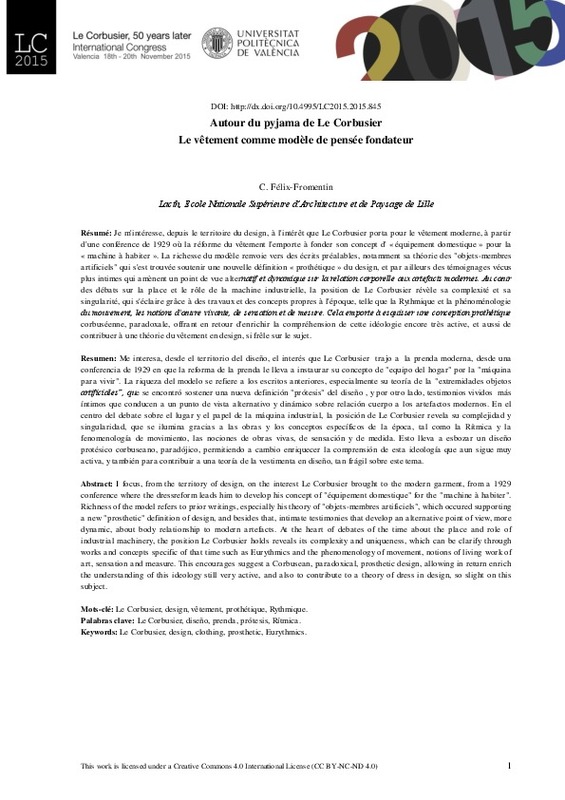JavaScript is disabled for your browser. Some features of this site may not work without it.
Buscar en RiuNet
Listar
Mi cuenta
Estadísticas
Ayuda RiuNet
Admin. UPV
Autour du pyjama de Le Corbusier Le vêtement comme modèle de pensée fondateur
Mostrar el registro sencillo del ítem
Ficheros en el ítem
| dc.contributor.author | Felix-Fromentin, Clotilde
|
es_ES |
| dc.date.accessioned | 2017-09-18T10:48:21Z | |
| dc.date.available | 2017-09-18T10:48:21Z | |
| dc.date.issued | 2016-03-03 | |
| dc.identifier.isbn | 9788490483732 | |
| dc.identifier.uri | http://hdl.handle.net/10251/87424 | |
| dc.description.abstract | [EN] I focus, from the territory of design, on the interest Le Corbusier brought to the modern garment, from a 1929 conference where the dressreform leads him to develop his concept of "équipement domestique" for the "machine à habiter". Richness of the model refers to prior writings, especially his theory of "objets-membres artificiels", which occured supporting a new "prosthetic" definition of design, and besides that, intimate testimonies that develop an alternative point of view, more dynamic, about body relationship to modern artefacts. At the heart of debates of the time about the place and role of industrial machinery, the position Le Corbusier holds reveals its complexity and uniqueness, which can be clarify through works and concepts specific of that time such as Eurythmics and the phenomenology of movement, notions of living work of art, sensation and measure. This encourages suggest a Corbusean, paradoxical, prosthetic design, allowing in return enrich the understanding of this ideology still very active, and also to contribute to a theory of dress in design, so slight on this subject. | es_ES |
| dc.description.abstract | [ES] I focus, from the territory of design, on the interest Le Corbusier brought to the modern garment, from a 1929 conference where the dressreform leads him to develop his concept of "équipement domestique" for the "machine à habiter". Richness of the model refers to prior writings, especially his theory of "objets-membres artificiels", which occured supporting a new "prosthetic" definition of design, and besides that, intimate testimonies that develop an alternative point of view, more dynamic, about body relationship to modern artefacts. At the heart of debates of the time about the place and role of industrial machinery, the position Le Corbusier holds reveals its complexity and uniqueness, which can be clarify through works and concepts specific of that time such as Eurythmics and the phenomenology of movement, notions of living work of art, sensation and measure. This encourages suggest a Corbusean, paradoxical, prosthetic design, allowing in return enrich the understanding of this ideology still very active, and also to contribute to a theory of dress in design, so slight on this subject. | es_ES |
| dc.description.abstract | [FR] Je m'intéresse, depuis le territoire du design, à l'intérêt que Le Corbusier porta pour le vêtement moderne, à partir d'une conférence de 1929 où la réforme du vêtement l'emporte à fonder son concept d' « équipement domestique » pour la « machine à habiter ». La richesse du modèle renvoie vers des écrits préalables, notamment sa théorie des "objets-membres artificiels" qui s'est trouvée soutenir une nouvelle définition « prothétique » du design, et par ailleurs des témoignages vécus plus intimes qui amènent un point de vue alternatif et dynamique sur la relation corporelle aux artefacts modernes. Au cœur des débats sur la place et le rôle de la machine industrielle, la position de Le Corbusier révèle sa complexité et sa singularité, qui s'éclaire grâce à des travaux et des concepts propres à l'époque, telle que la Rythmique et la phénoménologie du mouvement, les notions d'œuvre vivante, de sensation et de mesure. Cela emporte à esquisser une conception prothétique corbuséenne, paradoxale, offrant en retour d'enrichir la compréhension de cette idéologie encore très active, et aussi de contribuer à une théorie du vêtement en design, si frêle sur le sujet | es_ES |
| dc.format.extent | 10 | es_ES |
| dc.language | Francés | es_ES |
| dc.publisher | Editorial Universitat Politècnica de València | es_ES |
| dc.relation.ispartof | LE CORBUSIER. 50 AÑOS DESPUÉS | es_ES |
| dc.rights | Reconocimiento - No comercial - Sin obra derivada (by-nc-nd) | es_ES |
| dc.subject | architecture | es_ES |
| dc.subject | le corbusier | es_ES |
| dc.subject | modern movement | es_ES |
| dc.title | Autour du pyjama de Le Corbusier Le vêtement comme modèle de pensée fondateur | es_ES |
| dc.type | Capítulo de libro | es_ES |
| dc.type | Comunicación en congreso | es_ES |
| dc.identifier.doi | 10.4995/LC2015.2015.845 | |
| dc.rights.accessRights | Abierto | es_ES |
| dc.description.bibliographicCitation | Felix-Fromentin, C. (2016). Autour du pyjama de Le Corbusier Le vêtement comme modèle de pensée fondateur. En LE CORBUSIER. 50 AÑOS DESPUÉS. Editorial Universitat Politècnica de València. 660-679. https://doi.org/10.4995/LC2015.2015.845 | es_ES |
| dc.description.accrualMethod | OCS | es_ES |
| dc.relation.conferencename | LC2015 - Le Corbusier, 50 years later | es_ES |
| dc.relation.conferencedate | November 18-20,2015 | es_ES |
| dc.relation.conferenceplace | Valencia, Spain | es_ES |
| dc.relation.publisherversion | http://ocs.editorial.upv.es/index.php/LC2015/LC2015/paper/view/845 | es_ES |
| dc.description.upvformatpinicio | 660 | es_ES |
| dc.description.upvformatpfin | 679 | es_ES |
| dc.type.version | info:eu-repo/semantics/publishedVersion | es_ES |
| dc.relation.pasarela | OCS\845 | es_ES |








